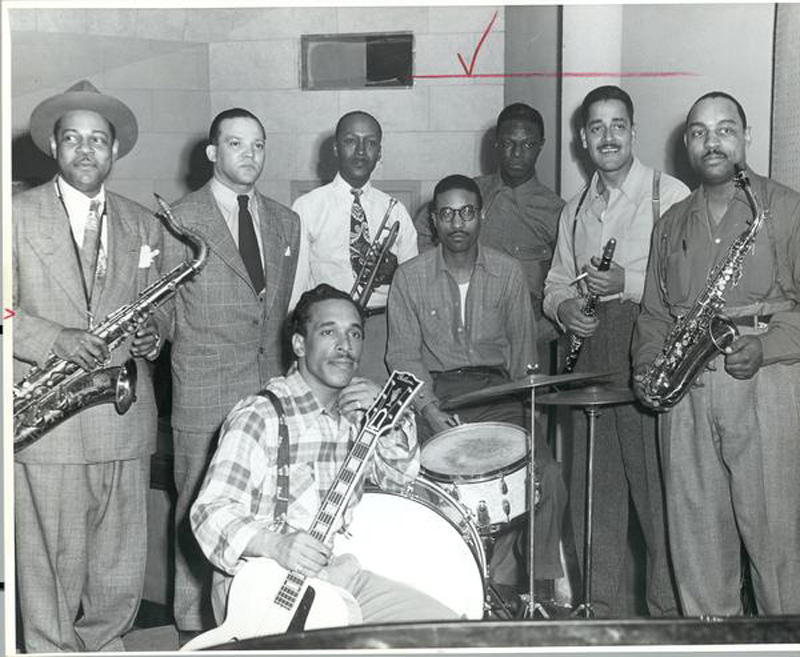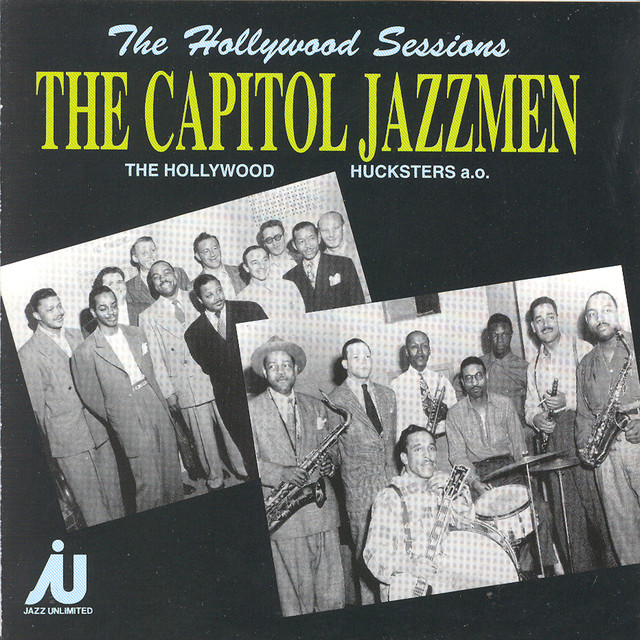Eight Men, a Young Woman and a Studio
20th October 2022Peter Gardner
According to one source the group was called ‘Dave Dexter’s International Jazzmen’, whereas, more accurately, the group’s name was ‘Capitol’s International Jazzmen’. Dave Dexter was involved; he was Capitol Records’ producer and he had assembled the musicians, but the group didn’t bear his name. ‘Capitol’ was the label they were recording for and as for ‘International’, this apparently came from the fact that three of the musicians had enjoyed longish spells in Europe. And the seeming grandeur of the title was certainly deserved: the group consisted of Coleman Hawkins, tenor sax, Benny Carter, alto sax and arranger, Buster Bailey, clarinet, Bill Coleman, trumpet, Nat King Cole, piano, Oscar Moore, guitar, John Kirby, bass, and Max Roach, drums.
Even bearing in mind that only Roach would count as a modernist, this must still stand as one of the very best octets one could get together in March 1945. ”Capitol”, according to Benny Carter’s biographers, had taken “advantage of the presence in Los Angeles of this dream personnel”, musicians from several backgrounds all on the West Coast. They would record only once together.

A photo, a woman and some discs
There was also a black and white photograph taken of the group, probably in a recording studio, by Charlie Mihn. On the photo’s left is Hawkins, immaculately suited with a matching wide-brimmed fedora, his tenor at the ready, and he is next to an equally well dressed, though bare-headed, Kirby. Then there is Bill Coleman, in a pristine shirt and tie, looking as if he has just hung up his jacket. The rest of the musicians are in shirt sleeves, none with ties, some with braces, as if they have just been snapped in the middle of a jam session. By the look of things, there are two groups; the well dressed and the rest who have just finished a lively blues. But where is the band’s singer? She is nowhere to be seen.
By 1945 Catherine Laverne Starks had already sung with Joe Venuti, Bob Crosby Wingy Manone and Charlie Barnet, so she had some experience of working with jazz musicians. Nevertheless, compared with most she now had as accompanists, Kay Starr, as she had become, was still finding her way. She sang with a fast vibrato, a full and clear voice and the two songs, ‘If I Could Be with You’ and ‘Stormy Weather’, that she sang with the Capitol Jazzmen could have helped the twenty-two year old’s her career. Yet, it would be the next decade before she began topping the charts. As for why she avoided the studio photo, at present I have no idea.
So, we have the musicians – all of considerable talent and most with excessive experience – , we have the vocalist and, if I have read correctly, the recording qualities of the studio were excellent, and that is the way they sound. What then of the music? To be honest, I’ve always thought of the music as brief and competent, rather than sparking or excelling; “Considering the magnitude of the talent, the results are less than spectacular” was the assessment of Carter’s biographers. John Kirby’s biographer, Alan Williams, simply gives us the line-up of musicians, adding, “Vocalist Kay Starr sang on two of the tracks.” Kirby was busy reforming his small group at the time and left no assessment or evaluation of the Capitol outfit.
Coleman Hawkins’ biographer, John Chilton, is perhaps a little more generous, noting that “the calibre of the musicians” assembled for the Capitol session “meant that no serious mishaps occurred”, but he warns “Inspiration is rarely at its highest points…” Nevertheless, Chilton commends Nat King Cole and finds words of encouragement in Carter’s and Hawkins’ fluency, not least in “the final title, ‘Riffamarole’”, which has its “series of high-class but urbane blues choruses”. All in all then, unless I am dealing with those who, for whatever reason, are aiming to fill gaps in their recordings, it would seem that the Capitol session from 30th March, 1945, is not one to be searched for with any great energy.

A second opinion
But hold on. Record producer Dave Dexter deserves to be heard: “I didn’t tell the musicians, but I also invited a young, busty, big-throated girl singer to participate on two of the four planned masters. She was Kay Starr, a confident, ebullient, part-Cherokee brunette, whom I had met when she worked for a time with Joe Venuti. She sang great.” Dexter continued: “It was a sensationally successful clambake. Nat played scintillating piano and Kay boomed out If I Could Be with You One Hour Tonight and Stormy Weather as if she owns the copyrights. The musicians applauded her. No critic had the temerity later to knock any of the four sides we captured. They were too beautifully performed.” Dexter adds that Nat King Cole, who was under great pressure to sing rather than play the piano, thanked him for arranging a group where he didn’t sing and thanks were also due from Kay Starr because the session “led to a longterm contract with Capitol and a new and lucrative career.” Everything was marvellous according to Dexter. Well, we have to agree Nat didn’t sing, but played superbly instead, and Kay Starr’s career would rise, but it did take a little while before it took off. As for the rest of the group? Well, let’s have a listen.
The four master takes plus two discarded alternates were eventually all released in the 1990s on the Capitol Jazz CD ‘Nat King Cole – Jazz Encounters’ (Capitol Jazz, CDP 7 96693 2), although copies might be found elsewhere. ‘You Can Depend on Me’ opens with some precise and relaxed piano from Cole, well supported by Moore’s guitar and Kirby’s bass. Bailey takes the next sixteen bars followed by Carter’s richly melodic alto, which to my ears makes him best soloist on this take. Bill Coleman’s sixteen bars are followed by Hawkins’ full-toned exploration of the whole and final chorus with the band riffing behind him. The alternate take follows the same route, with riffing behind most of Hawkins’ final chorus. Overall, this is warm and engaging, but there is nothing exceptional.
Kay Starr follows with ‘If I Could Be with You’, which Cole introduces beautifully. The singing and the delightful solos from Carter and Hawkins make this one of the best tracks from the session, though some might prefer the next, ‘Stormy Weather’, which has some subdued trumpet, excellent Carter and the usual flawless Cole accompanying a great vocal.
The final track from the set, plus an alternate, is ‘Riffamarole’, a 12 bar original by Benny Carter. Taken at a lively tempo, both takes allow most of the soloists to take two choruses, the exception being Hawkins who on the master take has a three chorus solo before the final ensembles. There is some nice playing on both of these tracks with little to choose between the soloists, but, again, nothing is exceptional. I can’t help feeling the best had maybe departed with the vocalist.

A reassessment
What then are we to make of the session? It was made at a time when World War Two was coming to an end and, in music, a new style was gaining in popularity. So we could say the Capitol session comes from a time of change, but there is nothing novel in what these instrumentalists play. Most of them are from an earlier period and, despite some of their efforts, would never lose what we later listeners will see as their mainstream allegiances. And their confinement to three minute recordings prevented us hearing the longer solos that would dominate their live concert performances.
Maybe, then, we should just be thankful for what we have been left, and be particularly grateful for the excellence of the pianist and the occasional flash of brilliance from Carter and Hawkins. As for the singing, although straightforward, it is confident, bold and assertive and adds greatly to the quality of these sides. There was nothing withdrawn about a young Kay Starr.
On reflection, these recordings aren’t at all bad. In fact, they are quite good. Am I being too generous? I don’t think so. Why not have a listen?
Peter Gardner
October 2022
Acknowledgements
I am grateful to my sister, Ann Gardner, and Dawkes’ woodwind specialist, Sam Gregory.
Some sources used
Morroe Berger, Edward Berger and James Patrick, Benny Carter: A Life in American Music, Volume 11 (The Scarecrow Press, Lanham, Maryland, 2001).
John Chilton , The Song of the Hawk (Quartet Books, London, 1990).
Dave Dexter, Playback (Billboard Publications, Inc., New York, 1976).
Burnett James, Coleman Hawkins (Spellmount Ltd., Kent, 1984).
Andy Williams, Fall from Grace: The John Kirby Story (Alcoral Books, Pensacola, Florida, 1996).